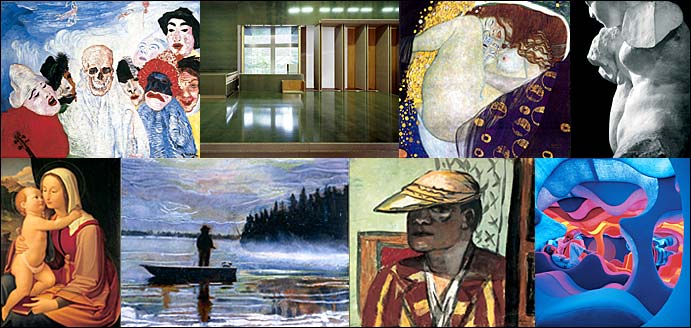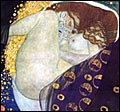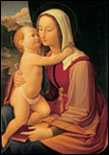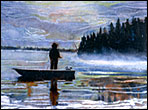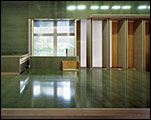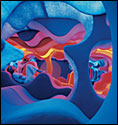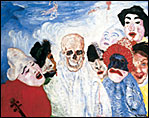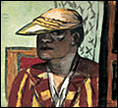"In 2005, the Schirn shows a series of great masters of the twentieth century, both in individual presentations and as part of major thematic exhibitions". underlines its Director Max Hollein. "The program begins with The Naked Truth, which presents masterworks by Klimt, Schiele, Kokoschka, and others, to reveal the provocative potential of Austrian art around 1900. The work of James Ensor also lies beyond social conventions. The Schirn is dedicating a large retrospective to him, which is intended to provide a new look at the late work in particular. Similarly, the large-scale presentation of watercolors by Max Beckmann will provide another view of a German master of modernism; in contrast to the paintings, the watercolors reveal the artist’s cheerful and spontaneous side. The juxtaposition of Joseph Beuys and Auguste Rodin might seem surprising at first, but the exhibition shows that the works of these artists reveal striking parallels. Parallels of a very different kind are drawn in the exhibition The Nazarenes, which uses the example of the Romanticist artists’ movement to explore phenomena and strategies of modernism. The exhibition Ideal Worlds does not explore historical Romanticism but rather a contemporary romantic trend, highlighting current developments in painting, photography, and video."
THE NAKED TRUTH - KLIMT, SCHIELE, KOKOSCHKA, AND OTHER SCANDALS
Until 24 April 2005
Vienna around 1900: steeped in tradition, life in the metropolis on the Danube oscillated between Catholic conservatism and artistic awakening. In conflict with the authorities, artists like Gustav Klimt, Egon Schiele, and Oskar Kokoschka broached taboo themes such as sexuality and power, homoeroticism, adolescence, and the battle of the sexes with visual, sensory, and intellectual energy. Egon Schiele was vehemently attacked for his radically open depictions of Eros, suffering, and death. Adolf Loos provided Vienna with one of the greatest architectural scandals in the form of what the contemporary press called his "obscenely bare" house on Michaelerplatz. The exhibition includes more than two hundred masterpieces of painting and drawing that offer a picture of Austrian art at the beginning of the twentieth century, going beyond fin-de-siècle romanticism in its uncompromising modernity, and with an explosive social power that it has preserved until today.
Illustration: Gustav Klimt: Danae, 1907-08, oil on canvas, 77 x 83 cm. Courtesy Sammlung Dichand.
RELIGION POWER ART. THE NAZARENES
15 April to 24 July 2005
In a time that sees a renaissance of religiosity and a new impact of an undercurrent religion without faith, this exhibition uses the example of the artists’ movement of the Nazarenes to explore the concepts, phenomena, and strategies of modernity. The German-Austrian-Swiss brotherhood around Johann Friedrich Overbeck, Franz Pforr, and Philipp Veit came together at the beginning of the nineteenth century with the goal of using artistic means to revive a Christian-influenced society. Its modernity lies in its attitude to religious matters and in its protest against society as well as in its conceptual idea of art. The exhibition attempts to shed a new light on an artists’ group that has been considered anti-Enlightenment because of its advocacy of a monastic lifestyle and a formal language based on Raphael and Dürer. The postmodern focus of the exhibition seeks to contribute to a new evaluation of the Nazarenes as the first movement of aesthetic modernism.
Illustration: Johann Friedrich Overbeck, Madonna with child, 1819, oil on wood, 65,8 x 47,1 cm. Courtesy Thorvaldsens Museum, Copenhagen, Photo: Ole Woldbye.
IDEAL WORLDS. NEW ROMANTICISM IN CONTEMPORARY ART
12 May to 28 August 2005
In a society marked by increasing mobility and dwindling social bonds, intimacy and security have become a new yearning. Inundated with bad news and images of terror, people have begun to long for places of security and redemptive perspectives. This situation is also reflected in the visual arts. Following the analytic explorations of discourse of the 1980's and 1990's and the conversion of art into a social act, it is evident there is a revival of the traditional work. A series of highly topical artists like Peter Doig, David Thorpe, Kaye Donachie, and Christopher Orr have picked up a thread of the Romantic spirit: the desire for the paradisiacal, the beautiful, and the fairy-tale. Fathoming this dimension, the artists employ not only painting but the key media of postmodernism like photography, installation, and video.
Illustration: Peter Doig, Lunker, 1995, oil on canvas, 200 x 266 cm. Courtesy Contemporary Fine Arts, Berlin. Photo: Jochen Littkemann, Berlin.
JAN DE COCK: DENKMAL 7
26 May to 11 September 2005
Jan De Cock is one of the most surprising newcomers on the art scene. Following a sensational museum debut in Ghent in 2001, the Belgian artist placed his most spectacular building in a shipyard in San Sebastian for "Manifesta 5". Jan De Cock’s interventions in space and time are always articulated in several stages. First, massive architectonic alterations break up the existing space. Wall, floor, and ceiling elements of wood and other materials and interlocking niches and boxes create a rigorous and geometric but also mysterious and seductive landscape that encroaches on the viewer’s gaze and continually reorganizes it. Finally, the process of creation of the artist’s temporary "Denkmäler" (monuments) is reiterated in the form of photographs. For the presentation at the Schirn, Jan De Cock will develop, for the first time in Germany, a monumental work that will penetrate the interior of the building from outside and transform the site.
Illustration: Jan De Cock, Denkmal 10, De Appel, Nieuwe Spiegelstraat 10, Amsterdam, 2003 © Jan De Cock, 2005.
RODIN BEUYS
9 September to 27 November 2005
The juxtaposition of drawings and sculptures by Joseph Beuys and Auguste Rodin may at first seem surprising. In fact, however, Beuys created hundreds of works on paper between 1947 and 1964, which reveal formal reminiscences of Auguste Rodin’s late drawings and watercolors. Although Rodin, unlike Beuys, was fascinated by the female body as an object of desire, both considered women to be the epitome of elemental transformative natural forces. Like Rodin, and Wilhelm Lehmbruck after him, Beuys’s three-dimensional works take up the idea of the torso as an autonomous form and of the fragment as the embodiment of the enduring. With more than one hundred works on paper and fifty masterpieces of sculpture, the presentation will shed light both on the relationship between Rodin and Beuys and on Beuys’s intense engagement with the work of Lehmbruck.
Illustration: Auguste Rodin, Iris, messagère des Dieux, plaster 160 x 95 x 60,5 cm. © VG Bild-Kunst, Bonn 2005, Photo: Bruno Jarret.
SUMMER OF LOVE
2 November 2005 to 12 February 2006
Psychedelia is one of the most interesting but also most neglected phenomena of the cultural history of the twentieth century. "Summer of Love" highlights the unparalleled connection between contemporary art and popular culture, the advertising culture and the pictorial language of the political protests of the 1960's and early 1970's for the first time. This dialogue found expression in a unique aesthetics that expressed social, political, ethnic, and sexual liberation as well as consciousness-expanding experiences through experiments with LSD. Works by Andy Warhol and Yayoi Kusama, spatial utopias by Verner Panton, as well as music videos by the Velvet Underground, concert recordings of Deep Purple, and a program of experimental films and the Hollywood productions they influenced. The exhibition reveals the creative and utopian potential of psychedelic art in all its urgency and demonstrates how profoundly it affected quotidian culture.
Illustration: Verner Panton, Phantasy Landscape, Visiona II, 1970 © Panton Design, Basel.
JAMES ENSOR
17 December 2005 to 19 March 2006
Scarcely any other artist of the late nineteenth century produced an oeuvre as bizarre, ironic, profound, and rich in interpretive possibilities as that of the Belgian painter James Ensor. His unusual motifs, which became unmistakable symbols of the absurdity of existence, influenced both German Expressionists and French Surrealists. Especially when seen in the light of new trends like the manifestation of the grotesque and comic in contemporary painting, Ensor’s work obtains new currency. With some seventy masterpieces on canvas and about forty works on paper from international museums and private collections, the exhibition presents key works from each of his creative periods. Particular attention is paid to Ensor’s late work, long neglected by scholarship, in order to prepare the ground for a reevaluation.
Illustration: James Ensor, The death and the masks, 1897, oil on canvas, 79 x 100 cm. © VG Bild-Kunst, Bonn 2005.
MAX BECKMANN: THE WATERCOLORS
3 March 2005 to 28 May 2006
Max Beckmann’s outstanding artistic work has been illuminated in numerous important exhibitions in recent decades. Thus it is all the more astonishing that he has yet to be assessed as a "painter on paper". The Schirn is presenting, with more than a hundred watercolors and pastels, including large-format works, the first opportunity to view together essential aspects of this work, which is dispersed throughout the world. This major survey –for which the Schirn will publish the first catalogue raisonné of the artist’s watercolors– will reveal the importance this work in a technique often described as ephemeral had for Beckmann. In contrast to the paintings, in which the problems of history and human existence are compressed, the watercolors display a humor, legerity, and stunning spontaneity, revealing a little-known facet of this great master of modernism.
Illustration: Max Beckmann, Selfportrait, 1938, gouache on paper, 37 x 61,6 cm. © VG Bild-Kunst, Bonn 2005.
|








